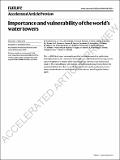Files in this item
Importance and vulnerability of the world’s water towers
Item metadata
| dc.contributor.author | Immerzeel, W. W. | |
| dc.contributor.author | Lutz, A. F. | |
| dc.contributor.author | Andrade, M. | |
| dc.contributor.author | Bahl, A. | |
| dc.contributor.author | Biemans, H. | |
| dc.contributor.author | Bolch, T. | |
| dc.contributor.author | Brumby, S. | |
| dc.contributor.author | Davies, B. J. | |
| dc.contributor.author | Hyde, S. | |
| dc.contributor.author | Elmore, A. C. | |
| dc.contributor.author | Emmer, A. | |
| dc.contributor.author | Feng, M. | |
| dc.contributor.author | Fernández, A. | |
| dc.contributor.author | Haritashya, U. | |
| dc.contributor.author | Kargel, J. S. | |
| dc.contributor.author | Koppes, M. | |
| dc.contributor.author | Kraaijenbrink, P. D. A. | |
| dc.contributor.author | Kulkarni, A. V. | |
| dc.contributor.author | Mayewski, P. | |
| dc.contributor.author | Nepal, S. | |
| dc.contributor.author | Pacheco, P. | |
| dc.contributor.author | Painter, T. H. | |
| dc.contributor.author | Pellicciotti, F. | |
| dc.contributor.author | Rajaram, H. | |
| dc.contributor.author | Rupper, S. | |
| dc.contributor.author | Sinisalo, A. | |
| dc.contributor.author | Shrestha, A. B. | |
| dc.contributor.author | Viviroli, D. | |
| dc.contributor.author | Wada, Y. | |
| dc.contributor.author | Xiao, C. | |
| dc.contributor.author | Yao, T. | |
| dc.contributor.author | Baillie, J. E. M. | |
| dc.date.accessioned | 2020-06-08T23:34:51Z | |
| dc.date.available | 2020-06-08T23:34:51Z | |
| dc.date.issued | 2020-01-16 | |
| dc.identifier | 264531075 | |
| dc.identifier | 07bea68a-4098-43b9-a32e-ce7fd698ec93 | |
| dc.identifier | 85077591595 | |
| dc.identifier | 000509570100032 | |
| dc.identifier.citation | Immerzeel , W W , Lutz , A F , Andrade , M , Bahl , A , Biemans , H , Bolch , T , Brumby , S , Davies , B J , Hyde , S , Elmore , A C , Emmer , A , Feng , M , Fernández , A , Haritashya , U , Kargel , J S , Koppes , M , Kraaijenbrink , P D A , Kulkarni , A V , Mayewski , P , Nepal , S , Pacheco , P , Painter , T H , Pellicciotti , F , Rajaram , H , Rupper , S , Sinisalo , A , Shrestha , A B , Viviroli , D , Wada , Y , Xiao , C , Yao , T & Baillie , J E M 2020 , ' Importance and vulnerability of the world’s water towers ' , Nature , vol. 577 , no. 7790 , pp. 364-369 . https://doi.org/10.1038/s41586-019-1822-y | en |
| dc.identifier.issn | 1476-4687 | |
| dc.identifier.other | RIS: urn:A9CD970B307EC8E4FA19F0B2DA4B897D | |
| dc.identifier.other | RIS: Immerzeel2019 | |
| dc.identifier.other | ORCID: /0000-0002-8201-5059/work/66398495 | |
| dc.identifier.uri | https://hdl.handle.net/10023/20056 | |
| dc.description | This project was funded as part of the National Geographic Society and Rolex partnership to support a Perpetual Planet. | en |
| dc.description.abstract | Mountains are the water towers of the world, supplying a substantial part of both natural and anthropogenic water demands1,2. They are highly sensitive and prone to climate change3,4, yet their importance and vulnerability have not been quantified at the global scale. Here, we present a global Water Tower Index, which ranks all water towers in terms of their water-supplying role and the downstream dependence of ecosystems and society. For each tower, we assess its vulnerability related to water stress, governance, hydropolitical tension and future climatic and socio-economic changes. We conclude that the most important water towers are also among the most vulnerable, and that climatic and socio-economic changes will affect them profoundly. This could negatively impact 1.9 billion people living in (0.3 billion) or directly downstream of (1.6 billion) mountain areas. Immediate action is required to safeguard the future of the world’s most important and vulnerable water towers. | |
| dc.format.extent | 46662594 | |
| dc.language.iso | eng | |
| dc.relation.ispartof | Nature | en |
| dc.subject | Mountains | en |
| dc.subject | hydrology | en |
| dc.subject | GE Environmental Sciences | en |
| dc.subject | DAS | en |
| dc.subject.lcc | GE | en |
| dc.title | Importance and vulnerability of the world’s water towers | en |
| dc.type | Journal article | en |
| dc.contributor.institution | University of St Andrews. School of Geography & Sustainable Development | en |
| dc.contributor.institution | University of St Andrews. Bell-Edwards Geographic Data Institute | en |
| dc.identifier.doi | 10.1038/s41586-019-1822-y | |
| dc.description.status | Peer reviewed | en |
| dc.date.embargoedUntil | 2020-06-09 |
This item appears in the following Collection(s)
Items in the St Andrews Research Repository are protected by copyright, with all rights reserved, unless otherwise indicated.

